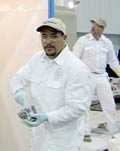|
The History of Plastering:
9,000 Years of Craftsmanship
The history of plastering of walls or ceilings dates back as far as 9,000 years ago. The material was used to set stone blocks and, ultimately, go over these blocks to make an attractive surface that could be painted or drawn on. As the material evolved, so did the craftsmen. The finishes became more elaborate, giving rise to bright colors, polished Italian finishes, scagliola finishes, frescos, and textures. The skills of these artisans were closely protected as the materials and the formulas they used only allowing a chosen few to know their secrets.
By this time, the art of ornamental plaster was flourishing. Decorative wall and ceiling moldings consisting of cornices, medallions, and coffers were made and added to the interior or exterior of buildings.
Later, mechanization became part of the plasterer’s trade. Machines now allowed plaster to be applied without using the traditional method of hand application. These machines allowed first, second, and even the finishing coat of plaster to be applied. Even so, hand application remains a distinct and fine art. Today, the trade of plastering has continue to develop; embracing new knowledge and skills and combing those with new materials that last longer, look better, and add a cost effectiveness that is equal or better to any other building product at this time.
Local 66: A Part of the San Francisco Bay’s History
- 1864 Operative Plasterers and Cement Finishers’ International organized nationally.
- 1904 San Francisco Plasterers Union organized.
- Post World War I the “open shop” movement or “American Plan” movement swept the US causing disruption between non-union employers and unions.
- San Francisco Plasterers Union ousted from International for disruptive activities in the wake of “open shop.”
- 1924 Union was readmitted to the International under a new charter.
- The Union weathered the years of the Depression and those during World War II and following.
- 1954 Frank Moran was elected as the Union’s first Business Manager.
- Under Moran (1954-1970), the Health and Welfare Program was established.
- In 1957, Moran oversaw the establishment of the Pension Program which also grand fathered and protected the Union’s oldest members; giving them a guaranteed pension.
- In 1970, John Moylan became the Union’s president then became its Business Agent .
- Moylan’s tenure saw extraordinary Union growth both in terms of membership, resources, and programs.
- Moylan engineered the mergers with San Mateo Local 38 (1972), Oakland Local 112 (1982), and the Pittsburg Local (1984).
- 1972 Upon completion of the first merger the Union officially became Local 66.
- Membership under Moylan grew from approximately 150 to approximately 400.
- Moylan established the Local’s apprenticeship program that attracted new members and publicly promoted the plastering craft. Also established the first apprenticeship competition.
- Moylan grew pension funds from approximately $800,000 in 1972 to approximately $130,000,000 when he retired in 1992.
- 1989 Michael Moylan elected Local 66 president.
- 1992 Michael Moylan elected Business Manager along with Tommy Savage as Business Agent.
- 1998 Michael Moylan becomes Vice President of the International.
- 1998 Chester Murphy, Sr. resigned as president of Local 66 and was elected Business Manager.
- 1998 Chester Murphy, Jr. “Chet” becomes Business Agent for Local 66.
|







